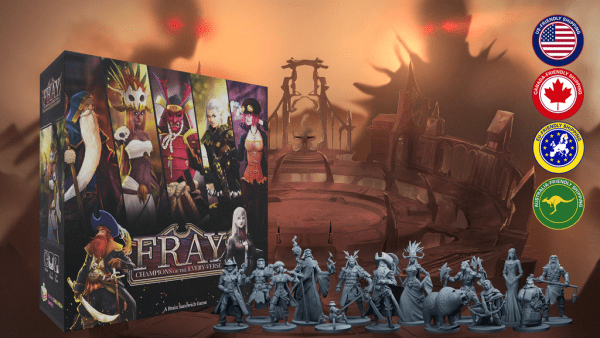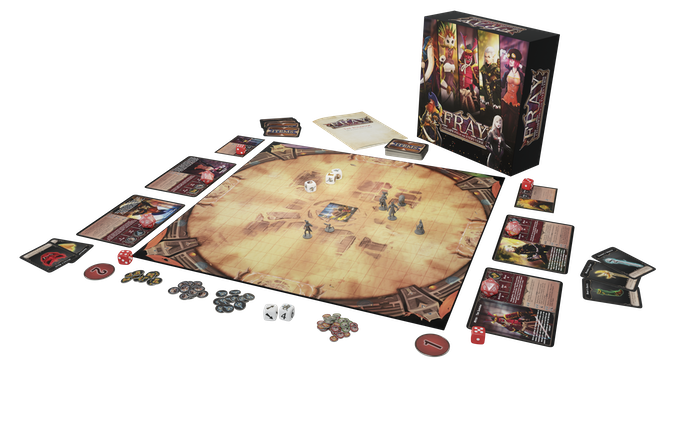Preview: Choose Your Team and Fight to the Death in Fray: Champions of the Every-verse

Who will be on your team? A sheriff? An orc? A vampire? The last team standing is the winner in this light, fast-playing skirmish game.
Currently on Kickstarter, Fray: Champions of the Every-verse has you choose your champions, then pits you against one another in an arena battle. So how exactly does it play?
Gameplay
There are two game modes: single mode, in which two players will each only control a single champion, or team mode, which is for playing with three to four players or when each player chooses to control multiple champions. Each player then rolls a die to determine the order in which they will pick champions. Each champion has various special abilities (which vary depending on which mode you are playing), an initiative number, a save number, and a move number. Each champion is also able to do melee attacks, short range or long range attacks, or a combination. Melee attacks may only be performed at the distance of one square, short range is up to three squares, and long range is up to five. Champions start the game with twenty hit points which are tracked with twenty-sided dice.
After you pick your champions, players decide which side of the board their team will start on and place their champion models on their start location. The goal of the game is to defeat all your opponent's champions.
At the start of each round, players select one of their champions to lead on the initiative roll and then all players roll a six-sided die and add that champion's initiative number to their roll. The player with the highest result goes first. You cannot pick the same champion twice in a row. This means in single mode, you only add your champion's initiative every other round.
Your turn starts with the item phase in which you can play any item cards that do not have an instant effect (instant cards can be played any time, including on another player's turn). Next, you choose which champion to activate first.
You then roll the three battle dice, which can show boot, shield, or axe icons. You may then move your champion as many squares as he or she has movement points marked on their character card (movement can be diagonal) and spend any additional boot icons to move one additional square per icon. If you are within one square of an opponent's champion and move away from it, that champion can spend one stored attack icon if they have it, in order to attack before you complete your movement. You can avoid this by spending a movement icon to make a guarded withdrawal.
After moving, your champion may perform one action. You may spend an axe icon to attack an enemy in range. The enemy then rolls a six-sided die. A one is an automatic hit; a six is an automatic miss. If the die rolls a number equal to or higher than your target's save number, it is also a miss. Some things will modify the attack so that the defender will add or subtract a number from their roll, such as item cards or special abilities. If hit, you then roll for damage. The damage die can roll a four, six, eight, or eight with a critical hit, which means the target will have a minus one modifier on all defense rolls for the rest of the round.
Another possible action you can choose is defense, which costs one shield and gives your champion a plus one modifier to all defense rolls until the start of their next turn.
Each champion also has their own unique abilities that are often more effective attacks or defenses, and which cost a combination of battle dice results. For example, one of these abilities might cost two axes, or two shields and an axe. Champions also have powerful once per game abilities.
Finally, if you did not use all the results on your battle dice, you may store up to two of them, taking tokens that match the results and placing them on your champion's character board. You may spend these next turn. If you don’t spend them next turn, they will be discarded. Some characters also have companions that they can summon to the board, and will act before the champion’s move, and which require these stored tokens to attack.
In team mode, after your champion has gone, you then activate your next one. Once all your champions have moved, it is the next player’s turn.
After all players have gone, you check the loot tile. It takes up four squares on the board and any player that has at least one champion within three squares of it, draws an item card. You then roll two dice to determine which direction the tile moves in and how many spaces. After moving the tile, you roll once more and move it again. It's now time for the next round!

Review
Fray: Champions of the Every-verse is a smooth gameplay experience. It takes a genre that is normally complicated and long, and distills it down into something accessible and strategically satisfying. You can keep the game short and sweet with only one champion per player, or add more layers to your choices and lengthen the game time by putting everyone in control of a team.
Since each champion can only take one action, downtime is low, and since a player being attacked gets to roll their save dice, or play cards if they have something applicable, you’re not totally on downtime even when it’s not your turn.
Choosing which tokens to save for next round is a neat mechanic, and a great way to be able to plan ahead, attempt to build up towards your special abilities, and have a reason to maneuver your champions to specific areas of the board. The moving loot token is a powerful incentive to keep moving around the board, as those loot cards can often give useful bonuses, help you survive a round, or even give you some extra health.
There are, however, some tweaks that could be made to help with the learning process. For example you have to check the rulebook to learn which types of attack each champion can make rather than being able to find the information on the character cards. Also, player aid cards with the phases of a turn would be helpful when learning the game. Tokens to indicate which champion was last used for initiative or when once-per-game abilities have been used would also keep things running a little more smoothly.
Otherwise, the components, even in the prototype we were sent, were excellent quality. We really enjoyed the artwork and the range of characters and their stories. Particularly in a team game, it’s enjoyable to not only figure out how the characters best fit together mechanically but also in the fiction of the world.
Fray: Champions of the Every-verse takes a little bit of extra time to learn, especially for the person going over the rulebook, but teaching it is fairly easy and the game itself plays at a nice brisk pace. We enjoyed the more casual approach to the skirmish genre, and that there was still plenty of strategy layered throughout the gameplay. Check it out on Kickstarter!
Pros: Artwork and characters, mechanic of carrying dice results over to the next round, limited downtime
Cons: A few component tweaks or additions would help make gameplay smoother
Disclosure: this preview is based on our evaluation of an unpublished prototype of the game, which is subject to change prior to publication. While a modest payment was received to expedite the review process, our thoughts and opinions expressed here are honest and accurate.




